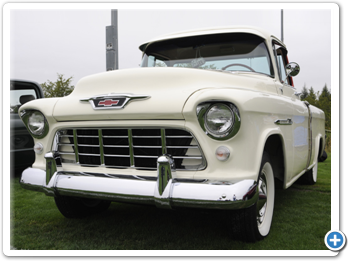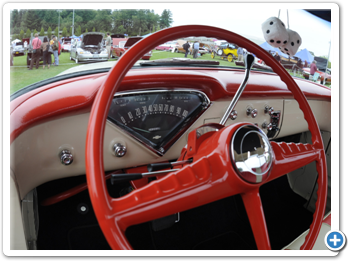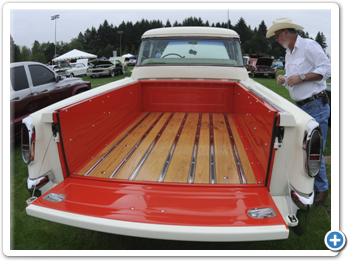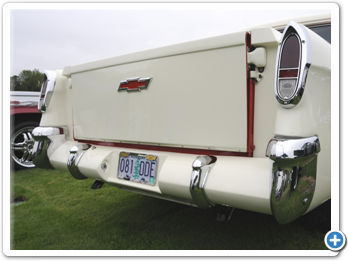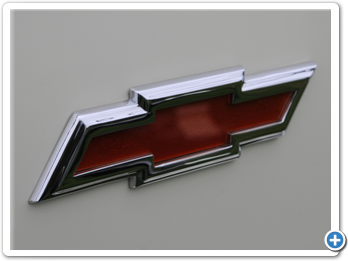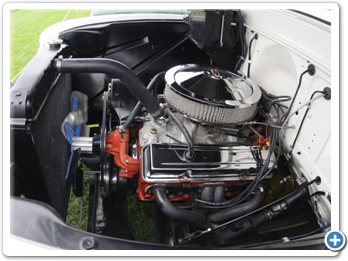Story and photos by Jerry F. Boone
|
“I was trying to come up with something like the cars I drove when I was younger,” he says.
There were coupes, sedans and convertibles that needed not much more than a wash and an oil change to be on the road.
And then there was this truck, piled up in boxes and pieces, the fenders hanging on the wall.
“Naturally, that’s the one my wife wanted,” he says with a sigh.
He tried to steer her back to the road-ready cars, but she always came back to the truck.
And that’s how he came to own a rare 1955 Chevrolet Cameo.
“Any of the other ones would have been a lot easier to get back on the road,” he says. “But I’m not sure they would have drawn as much attention as the Cameo.”
The truck was among about 5,000 made during the first year of production. It was Chevrolet’s styling centerpiece in the truck line until the Bow Tie boys replaced it with the long-running El Camino series. Overall production of the Cameo is believed to be fewer than 10,000 for the entire run.
They were never big sellers for Chevrolet, as they were aimed at a market that was just emerging. Back then, stylish and trucks were words seldom used together.
The Cameo was designed with the help of the team that penned the groundbreaking Corvette, to draw attention to the upgraded Chevy line of “Task Force” trucks, which featured wrap-around windshields and modernized bodies, more car-like interiors, beefier frames and upgraded suspensions.
Melton’s car is finished in Bombay Ivory with industrial red highlights. He says it is the only color the pickup was offered the first year.
The Cameo was designed to be a “gentlemen’s truck” he says. It was the first one to be styled “so the ladies wouldn’t object to being seen in it.”
They began life as a standard Chevrolet light duty pickup, then had sculptured, fiberglass fenders added to soften the industrial lines. The bed is wood -Melton restored his using red oak -with stainless steel rails.
The tailgate also is covered with a styled fiberglass piece, and the spare tire lives under the bed, behind a drop down panel that sits between the chrome bumper extensions.
While he bought the project in the mid-1990s, it stayed in the warehouse until 2007. It might still be there, except the building was sold and it needed to be emptied.
He brought the project home in pieces and parts.
“The job was made more difficult because I didn’t take it apart, and over the years some of the pieces disappeared. There are a few, like the tailgate handles that you just can’t find. It also took a long while to come up with the unique chrome pieces that hold the spare tire cover in place.”
In spite of the challenges, he said it took only about nine months to put it back together.
“And a lot more money than I ever envisioned,” he says.
One of the most time-consuming parts of the restoration was fitting the unique fenders.
“They had been hanging on the wall for a lot of years and over time they had warped pretty badly. We had to cut them apart and section them to get them to fit right and then ‘glass them back together.
“I suppose it would have been easier to get replacement ones, but I wanted to keep things as original as I can,” he says.
He did compromise on the powertrain.
“I still have the original engine and transmission, but during the restoration work the transmission was dropped and the bell housing cracked,” he says. “I plan to put it back in some day.”
Instead of the original “Stovebolt” 6-cylinder engine, Melton dropped in the ubiquitous Chevrolet 350 mated to an automatic. It was an easy swap and looks right at home under the hood. It is also a period-correct swap, in that it was a common owner-induced upgrade to the stylish bodywork.
And, while the 123-horsepower 6-cylinder was the most common engine in the trucks, they also were offered with the new 265 cubic-inch V-8, which contained the DNA for generations of small block Chevrolet engines.
But other than the newer 350, it’s all original.
“That means it is still a truck,” he says, “and an old one at that.”
There is no power steering. No power brakes. Heck, it’s still got drums on all four corners. You want air conditioning? Open a window.
It was well optioned for its time. That means it has bumper guards and a sun visor.
“You forget how truck-like trucks were back then,” he says. Of course, “back then” you didn’t find trucks in every-other suburban driveway.
“I’ve owned a lot of cars over the years,” he says, “but most of them were just cars. I’ve never had a ‘keeper car’ car before. This one I’m keeping.
“I’ve been tempted to modify it,” he admits, “but I think changing it would ruin it.”
Source: popularrestorations
